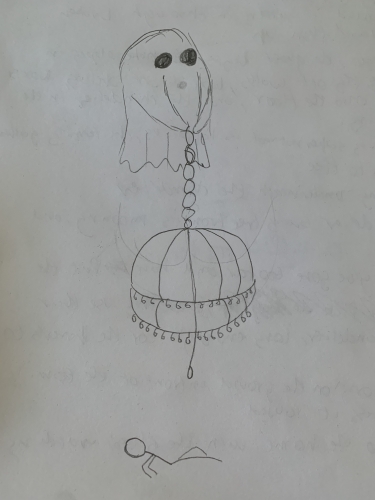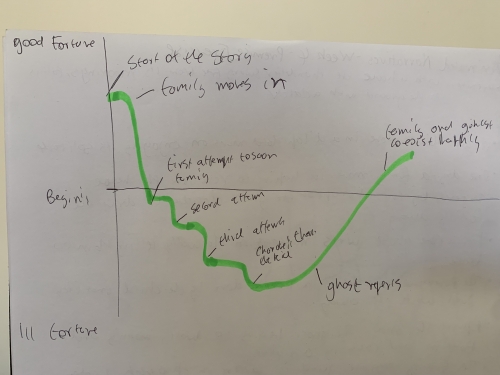
I started off this week's activity by redoing the premise exercise, which was to use the premise as a conclusion, and then reverse engineer a story in dot points that arrives at that ending. I decided to use one of my premise posts, which was ‘with a final heave the chandelier swung free from its moorings, falling to the ground with a clatter’. Kate’s feedback on the premise prompted me to consider why the chandelier was falling; was it acting on its own agency, or was it an inanimate object that was falling due to the actions of something or someone else. Also through doing this exercise I realised that while I liked this idea as the climax of a story, I didn’t necessarily like it as the ending/resolution, so I added a few more points to properly resolve the situation. The plot synopsis I developed using this exercise was…
- A ghost lives alone in a dilapidated mansion, enjoying its solitude.
- One day a family (Two dads and a preteen child) moves in, hoping to renovate the house.
- Angered by this disruption to its peaceful existence, the ghost decides to drive the family away.
- First, the ghost writes messages on the walls, threatening the family and demanding they leave.
- The parents assume that this is a prank done by their child, and so just wash the messages away.
- After this, the ghost ups the ante. It begins to make noise, moaning and groaning and trying to scare them off.
- The parents assume that wind is getting into the house through broken windows, causing the noise, and so board the windows up.
- In a final fit of anger, the ghost (becoming a true poltergeist) starts to move objects in the house. Pictures begin to rattle on walls, books fly off of bookshelves, dressers throw their contents to the ground, and the chandelier in the foyer begins to swing.
- Finally scared, the family prepares to leave the house, gathering in the foyer, with the child waiting dangerously close to the chandelier.
- With a final heave the chandelier swings free from its mooring, and begins to fall to the ground.
- The ghost realises that it’s gone too far, and has put the family in danger. They use their ghostly powers to hold up the chandelier, long enough for the parents to rescue the child.
- The ghost writes ‘I’m sorry’ on the ground in front of the family, and clears up all the mess it caused.
- The family settles into the house, with the ghost quietly watching over them.
Taking the story that I ended up at the end of this activity, I then thought about what the shape of this story would be. Thinking back to the examples given by Kurt Vonnegot in his Shapes of Stories lecture (and the additional examples given in the ‘The Six Main Arcs in Storytelling, as Identified by an A.I.’ article) I felt that this story most closely matched the ‘Main in Hole’ story shape. The main character, the ghost, starts off with good fortune, as they are enjoying their solitary life. This good fortune is diminished by the arrival of the family, disturbing the ghosts' quiet existence. The ghost's fortune continues to drop as their attempts to drive the family away fail, culminating in the moment where the chandelier falls and threatens the life of the child. After this, with the ghost making amends to the family, their fortunes rise, as they learn to happily coexist with the family in the house.
Through developing the story with this exercise, I came to realise that the theme of the story I was trying to tell was about accepting change, and changing circumstances. The ghost initially tries to resist the arrival of the family, and drive them away so that it could resume the life it was used to, with most of their actions being a reaction to the presence of the family. This resistance is futile however, and it's only when the ghost learns to co-exist with the family, and adapt to their new living conditions, that the story is resolved.
The work suits the medium of animation due to its focus on the non-human character of the ghost, who is depicted as a very stereotypical ‘bedsheet’ style ghost, and the ability that animation gives to easily depicts the supernatural events occurring over the course of the story.
Because my concept tries to portray the ghost in a sympathetic light, an example of a related work would be the 1988 film Beetlejuice (trailer here) directed by Tim Burton. This film has a similar story, depicting a ghostly couple who take issue with the new residents of their beloved home, and a similar conclusion, the ghosts and the living family coming together to peacefully cohabitate in their home. I was also thinking about the ‘Bad Dreams House’ segment of the original ‘Treehouse of Horror’ episode of The Simpsons (partially watchable here) which was itself a spoof of several 1980's horror films. In the segment, the Simpson family move into a haunted house, and experience a variety of apparitions and supernatural occurrences. The segment ends with Marge giving the house a lecture, telling it that it's just going to have to learn to live with the Simpson family as residents. The house responds to this ultimatum by removing itself from existence, rather than choose to live with the Simpsons.


